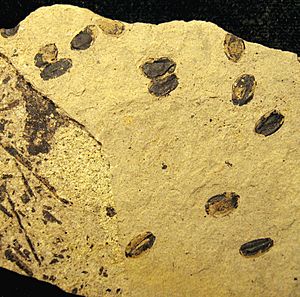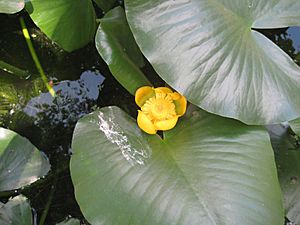Nuphar carlquistii facts for kids
Quick facts for kids Nuphar carlquistii |
|
|---|---|
 |
|
| Nuphar carlquistii seeds | |
| Scientific classification | |
| Genus: |
Nuphar
|
| Species: |
carlquistii
|
Nuphar carlquistii is an extinct type of flowering plant. It belonged to the water lily family, Nymphaeaceae. This ancient plant was similar to the modern spatterdock, which is called Nuphar advena. Scientists have learned about Nuphar carlquistii from its fossil seeds and fruits. These fossils were found in rocks from the early Eocene period. They were discovered in northern Washington state, United States, and in British Columbia, Canada.
Contents
Discovering Ancient Water Lilies
Fossils of Nuphar carlquistii have been found in two main places in North America. One spot is the Klondike Mountain Formation near Republic, Washington. These fossils are about 49 million years old. The other place is the Thomas Ranch area near Princeton, British Columbia.
Scientists use special methods to figure out how old these rocks and fossils are. They use techniques like uranium-lead dating and argon–argon dating. These methods help them know that the fossils are from the Ypresian age, which is part of the early Eocene period.
Naming the Nuphar carlquistii
Three paleobotanists, Melanie DeVore, Witt Taylor, and Kathleen Pigg, studied these fossils. A paleobotanist is a scientist who studies ancient plants. They officially described N. carlquistii in a science paper in 2015.
They named the species carlquistii to honor Sherwin Carlquist. He was a famous plant biologist who did a lot of work on water lilies. The name was given specifically to the fossil fruits and seeds. Other parts, like flower petals (called tepals) and root sections (rhizomes), were also found. These were thought to be from the same plant, but they weren't directly attached to the fruits or seeds.
One of the root sections was once thought to be from an ancient banana plant! But later studies showed it was actually part of this ancient water lily. The fossils show that Nuphar carlquistii had a barrel-shaped fruit with grooves. Its top part, called the stigmatic disk, had wavy edges. These features are very similar to the living spatterdock, Nuphar advena.

What Nuphar carlquistii Looked Like
The fruits of Nuphar carlquistii were about 2.5 cm (0.98 in) to 3 cm (1.2 in) wide. They grew from a base that was about 2 cm (0.79 in) wide. Each fruit had five tough, leaf-like parts called tepals around it. These tepals had special hard cells inside them. One fossil fruit even showed at least sixteen stamens, which are the parts that make pollen. Another fruit had about ten seeds still inside it.
Seeds of the Ancient Plant
Scientists also found many individual seeds and groups of seeds. Some groups were quite large, measuring up to 6.4 cm × 4.8 cm (2.5 in × 1.9 in). One fossil had hundreds of seeds packed closely together. They were surrounded by a thick, jelly-like substance. Scientists believe this was the natural jelly that helped the seeds spread from the fruit. Other seed groups had less of this jelly and were not as tightly packed.
Each individual seed was about 4–5 mm (0.16–0.20 in) long. They were oval or barrel-shaped. At one end, each seed had a small lid-like part called an operculum. There was also a clear ridge, called a raphe, running down the side of each seed. Even though most of the seed's outer layer wasn't perfectly preserved, scientists could see the distinct pattern of its cells. These cells were small and pentagon-shaped with straight walls. This cell pattern is a key feature found in both fossil and living Nuphar plants.

